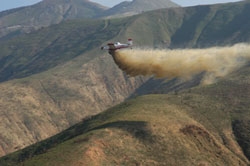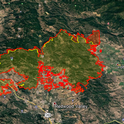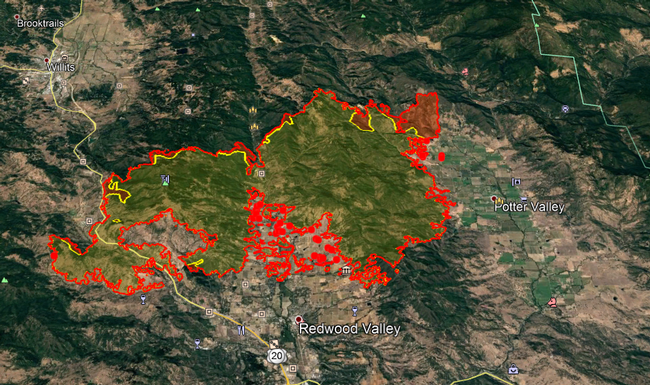- Author: John M Harper
For those of you that have been impacted by past or current wildfires in relation to loss of rangeland forage, the YouTube video link and related website below would be good resources to review to help calculate forage loss. If you know of anyone with grazing lands impacted by the 2020 fires, please distribute. Also any of you that have current loss of structures, fences, stock and forages, it is always helpful to hear from you so we can summarize (without identifying individuals) to share with policy-makers. This information is often used to request federal disaster funds. Thanks in advance and stay safe!
https://ucanr.edu/sites/forageloss/
- Author: John M Harper
- Author: John M Harper

The current cost is $9/acre for 10 pounds/acre seeding rate and $10/acre for 20 pounds/acre seeding rate. If more landowners participate with more acres the price may go down. Gibson plans on being here on the Sunday after Thanksgiving which is November 26, 2017. Diane, Devon (Farm Bureau), Katie Delbar (FSA) and I are working together to get the word out not just the ranchers who have been affected by the fire, but also any rancher who would like to take advantage of the plane being in the area to get some seeding done. Diane was told that Gibson said that he would help to source seed. Feel free to share this information with anyone you think might want to be involved.
Usually the goal for a cattle, sheep or goat livestock operation is to maximize high quality forage production. Typically on the North Coast, a 50:50 mix of annual grasses and legumes are recommended and seeded at 20 to 25 lbs per acre. The grasses are usually annual ryegrass, brome and fescue. The annual legume is subterranean clover. In areas of less steep topography and good soils, Berber orchardgrass, a perennial, may be substituted for part of the grass mixture. Perennials extend the green season providing better forage and enhance carbon storage. Many, however, don't compete well with annuals and have difficulty surviving our hot dry summers. A recent paper in California Agriculture was just published on some other promising forage perennials. The study was done in the Sierra foothills and a few of those mentioned have been tested here. The link to the current issue is http://ucanr.edu/repository/fileAccessPublic.cfm?calag=fullissues/CAv071n04.pdf&url_attachment=N. The range seeding paper starts on page 239.
For those interested in using California native grasses and forbs check out the following publication at http://ucanr.edu/sites/BayAreaRangeland/files/267610.pdf. Be aware that seed sources for natives will often cost more than 10 times the typical forage species. Also some are toxic to livestock or are not great forage species.
- Author: John M Harper

Post fire inventories include a lot for ranchers, e.g. stock, forage, fence, buildings and equipment losses immediately come to mind. Equally important is an inventory of potential sediment sources from hill slopes, fire cut roads and riparian areas that will need mitigation to prevent soil loss and sediment movement into streams.
Rice straw as mulch, in bales for check dams and in the ubiquitous waddles all come into play for the recovery process. Sometimes the mulch is also used in reseeding sites too. The following sources of rice straw were put together by Rachel Elkins, pomology advisor and were forwarded to me by Greg Giusti, forestry and wildlands advisor - emeritus.
Paul Buttner of the California Rice Commission (https://twitter.com/PaulTheRiceGuy). His website is: http://www.ricestrawmarket.org/index.html. It is a buyer-seller website. His phone number is (916) 206-5340. His twitter page links to http://calrice.org with more contact information.
Ken Collins, a rice grower in Gridley (Butte County) is a large rice straw dealer. His phone number is (530) 682-6020.
EarthSavers makes straw wattles. They are in Woodland: http://www.earth-savers.com/.
Once you have an inventory of potential sediment sources identified, contact the Natural Resources Conservation Service (NRCS) for technical help with mitigation and design of erosion control structures. I've included Carol Mandel's contact information below. Many of these mitigation techniques will have cost share programs to help.
Carol Mandel
USDA Natural Resources Conservation Service
1252 Airport Park Blvd. Suite B-1
Ukiah CA 95482
Bus: (707) 468-9223
Email: carol.mandel@ca.usda.gov

- Author: John M Harper
The U.S. Department of Agriculture (USDA) offers the Livestock Indemnity Program (LIP) to reimburse producers up to 75% of the market value of animals lost due to adverse weather conditions. Adverse weather conditions under LIP include wildfires. All classes of cattle are eligible for reimbursement including cows, bulls and calves. For 2017, a claim for a bull is paid out at $1,350.34, a cow at $1,038.73 and non-adult cattle (calves) from $471.22 per head to $1,001.12 per head depending on weight.
Sheep, goats and other stock including poultry are also eligible. There reimbursement rates for them are shown in tables in the document link included at the end of this post.
In order to be eligible to receive payment under LIP, a producer must notify their local county Farm Service Administration (FSA) of their intent to seek a claim within 30 days of the loss (see Katie Delbar's contact information below).
Katie Delbar
1252 Airport Park Blvd., Ste B-1
Ukiah, CA 95482
Bus: 707) 468-9225 ext. 2
Email: Katie.Delbar@ca.usda.gov
A final claim must be submitted within 90 days of informing the county FSA office of the loss and the final claim must also be made within the same calendar year as the loss. Documentation will be requested by the county FSA office to verify the claim including any photographs that can be made available documenting the loss or the impact of the fire, records to prove ownership, etc.
A fact sheet about the Livestock Indemnity Program can be found here.


